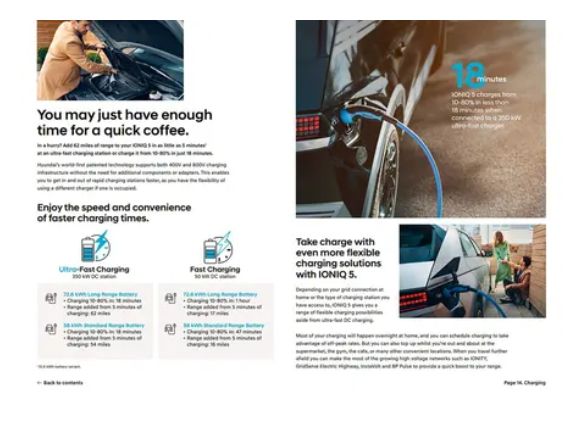On 28th June 2023, Hyundai and Toyota found themselves on the wrong side of the Advertising Standards Authority (ASA) relating to a decision that touches on the automotive and environmental sectors.
The ads
For Hyundai, the decision related to three ads for its IONIC 5 model, seen in January 2022.
1. A digital billboard in Piccadilly Circus featuring a "10% to 80% charge in 18 minutes using 350kw charger" text.
2. A YouTube video featuring Chelsea FC footballers with an an audio and on-screen text stating that "Both teams must complete the challenges within 18 minutes. That's the time that it takes the IONIQ 5 to charge from 10-80%".
3. And a marketing brochure on Hyundai's website which stated that "IONIQ 5 charges from 10% to 80% in less than 18 minutes when connected to a 350 kw ultra-fast charger". The marketing brochure did, however, include caveats about how to achieve ultra-fast charging.

In Toyota's case, the investigation related to an ad on its own website, seen in March 2022. The ad promoted its bZ4X model and featured the text, claiming to"Making electric easy. ...Three charging options offer flexibility - use rapid public charging to reach 80% charge in around 30 minutes* with a 150 kW fast-charging system, charge through a fast charging wallbox which can be installed at home, or plug into a socket at home". The asterisk linked to a further text which stated that "*Charging times subject to local circumstance. Rapid charging power ratings can vary by location".
The issue
In both instances, the complainants believed that there were significant limitations to achieving the advertised charging rate, such as temperature, which were not spelled out - and that that was potentially misleading.
Responses by Hyundai and Toyota
Hyundai said that their ads are intended to inform consumers about a fundamental feature of electric vehicles in general, and that it was "essential" to be able to promote charge times. They provided results of internal factory testing which did in fact charge the battery from 10% to 80% in 17 minutes and 16 seconds using a 350kW ultra-fast charger, with the battery at temperatures of 22 and 25 degrees centigrade. They also provided a YouTube review showcasing charging abilities in a "real-world environment" and as such, believed that its claims were just and substantiated.
Hyundai accepted that there are many variables which impact charge time, such as temperature or battery age and condition. However, they also believed that an average consumer would be aware that "ultra-fast" indicated a different charge speed from "fast, standard or slow".
Toyota followed a similar approach, stating that consumers, whilst familiar with electric vehicles, had concerns about charging. As such, the claim was was intended to alert consumers to rapid advances in battery and charging technology.
Toyota considered its claim to be "conservative", rather than absolute, because it stated that the battery could achieve a 80% charge "in around 30 minutes",which was caveated with the aforementioned asterisk. As such, Toyota did not consider the ad to be misleading, because the average consumer would understand existence of variable circumstances impacting charge times.
Toyota also stated that the ad was unlikely to be misleading, because at the time when the bZ4X model was launched, there were 946 charging points in the UK, although they could not provide the precise location of 150kW charging points required for the ultra-fast charge. Because ultra-fast charging was less likely to be a suitable for most drivers undertaking short journeys, a less powerful public charger was likely to be sufficient.
The decisions
The ASA upheld the complaints against all four ads. The regulator concluded that the ads omitted material information that significantly affected the advertised charging time. As such, the claims were not substantiated and were misleading.
In relation to Hyundai, the ASA considered that an average consumer would consider the "10% to 80% charge in 18 minutes using 350kw charger" to mean that the IONIQ 5 would always achieve such battery charge when using a 350kW charger.
The aggravating factors behind the ASA's decision were the various factors that impact real-world charge-time, such as temperature and battery age, which impact charge times. As such, an 18 minute charge is possible only if these conditions are optimal, which they will almost always not be. Whilst Hyundai's tech included battery cooling, it only covered one of several factors impacting charging time.
The ASA also emphasised the limitations of the claim due to the availability of 350kW chargers. This is because they considered that an average consumer may not be aware of the speed or availability of a 350kW charger in comparison to others, although interested consumers may have a little more knowledge and awareness of having to travel to access such ultra-fast charging points.
In Toyota's case, similarly, the ASA considered that an average consumer would understand the claim "use rapid public charging to reach 80% charge in around 30 minutes with a 150 kW fast-charging system" as an absolute one. Whilst there was an asterisk, the ASA considered it to be unclear as to its impact on charge times.
Again, the ASA substantiated its decision by referring to various real-world factors like temperature and battery conditions increasing charge times, unless of course these factors were optimal. Whilst Toyota's car tech also included battery cooling, it is one of many factors in play.
Take-home
Electric vehicles are a part of a collective drive towards achieving a cleaner and more sustainable environment, and advertisements for EVs are high on the ASA's agenda. In line with this focus, it was only last week when the ASA published an updated version of their guidance on misleading environmental claims. Whilst it is a whole separate topic, you can read our comments on the guidance here.
Toyota and Hyundai's claims might have been true, strictly speaking, but they left out important caveats - the existence of which meant the main claim should not have been expressed in such a strong/absolute a manner.
So bold claims sell, but sometimes need to be tempered if they give a misleading overall impression.
{ We understood from the Charge myHyundai website that, in April 2022, there were 37 ultra-fast 350 kW charging locations in Great Britain, six in the Republic of Ireland, limited numbers in Wales and Scotland and none in Northern Ireland.
https://www.asa.org.uk/rulings/hyundai-motor-uk-ltd-g22-1147624-hyundai-motor-uk-ltd.ht
The content of this article is intended to provide a general guide to the subject matter. Specialist advice should be sought about your specific circumstances.


